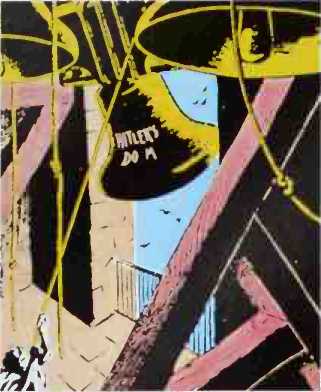Both on his own initiative and in virtue of the orders he received from Paris, General de Lattre was absolutely determined to hold Strasbourg. And so, on the night of January 2-3, he promptly sent in the solid 3rd Algerian Division, under the command of General du Vigier, recently appointed governor of the city.

A "For whom tolls the bell?"
"It tolls death for Hitler." And with the Allies on the Rhine and Oder, the defeat of the Third Reich and Hitler’s suicide were only weeks away.
For inter-Allied strategy. That is why, at 2200 hours on January 3, he was very happy to receive the signal announcing that the 6th Army Group had received new orders.
As a result, the American VI Corps, between the Rhine and the Sarre, received orders to continue its retreat only as far as the Moder. But, on January 5, while VI Corps was digging in at this position and the 3rd Algerian Division completed its positions in Strasbourg, the 553rd Volksgrenadier Division crossed the Rhine at Gambsheim, between Strasbourg and the confluence of the Moder and Rhine. The next day, it was the turn of the German 19th Army to go over to the offensive, from the Colmar bridgehead. Pressing between the 111 and the Rhone-Rhine Canal, the "Feldherrnhalle” Panzer Brigade and the 198th Division managed to get as far as the Erstein heights, less than 13 miles from Strasbourg and 20 from the Gambsheim bridgehead that the 553rd Division had extended as far as the village of Killstett.
Around Strasbourg, attack and counter-attack followed ceaselessly. The Germans had forced the Moder a little above Haguenau and for a short time managed to establish a link with their 553rd Division. However, on January 26, they had definitely lost it again and the battlefield fell silent. O. B. West was very unhappy with the tactics Himmler had used in this offensive, for, instead of wearing down the enemy, he had wasted 11 divisions, four of them of the Waffen-S. S., frittering them away in piecemeal actions, ignoring the fact that the barrier of the Rhine prevented him from coordinating their movements. All the same, it was General Wiese who paid for the failure of "Nordwind”. He received the order to hand over command of the 19th Army to his comrade Rasp. As for Himmler, his flattering promotion to the command of Army Group "Vistula” led, on January 28, to the appointment of Colonel-General Hausser, still recuperating from the wounds he had received during the bloody fighting in the Falaise pocket, to command of Army Group "Oberrhein”.
In spite of Operation "Nordwind”, on January 15 de Lattre signed his "Personal and Secret Instruction Number 7”:
"Leave the Germans no chance of escape. Free Colmar undamaged. The task consists of strangling the pocket alongside the Rhine where it receives its supplies, that is around Brisach.
"Two convergent wedges will be driven in this direction. The first will go northward and will be made by Bethouart’s I Corps, which will throw the enemy off balance and suck in his reserves. Then, two days later, II Corps will go into action. This staggering is required by the time it will take to get the expected reserves into place. Its effect will be to increase the surprise of the enemy. Between the two offensive blocs, in the high Vosges, the front will remain inactive at the beginning. It will begin to move when our net along the Rhine is so tightly stretched that the fish is ready to be pulled in.”
At this time, Devers and Eisenhower were so concerned about cutting off the Colmar pocket quickly that they did not hesitate to provide substantial reinforcements for the French 1st Army: the U. S. 3rd Division remained under its command, and it also received, though with certain limitations, the 28th Division and the 12th Armoured Division (Major-Generals Norman D. Cota and Roderik R. Allen), as well as the French 2nd Armoured Division under Leclerc, transferred from the Strasbourg area specifically for this purpose.
So, by January 20, 1945, the forces available to de Lattre amounted to 12 divisions, four of which were armoured. However, it should be pointed out that the 3rd Algerian Division was still engaged in and around Killstett and did not take part in the battle of Colmar and that, in the high Vosges, the newly-created 10th Division (General Billotte) was restricted to the modest role described above.




 World History
World History









